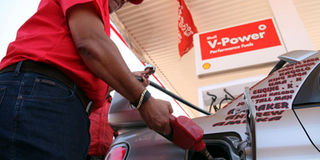Why fuel prices hit a five-year low

Vivo Energy Uganda AMD Hans Paulsen fuels a car recently. Just like other previous Budgets read by the finance minister, the government is in the next financial year 2016/17 proposing an increase in excise duty of Shs100 on each litre of diesel and petrol. PHOTO BY STEPHEN WANDERA
What you need to know:
Reason. The drop has been attributed to a fall in the World Crude Oil Prices.
Kampala.
When Uganda’s often sticky downtrend in fuel prices have been at lows last seen in 2010. Pump prices have for the last one month been at an average of Shs3,150 for a litre of petrol and Shs2,450 for a litre of diesel right across the country.
Some fuel stations have prices much lower than that. These price levels are the lowest the country has experienced in five years.
The lag effects of the fall in crude oil prices and the stable Uganda Shilling have been the contributing factors to this downward trend.
“The drop in the world crude oil prices is one of the factors behind lower pump prices we are experiencing on the market today. Fuel pump prices in Uganda have gone down by over 20 percent lately and this is an indication of responsiveness to market dynamics,” Mr Florentin de Loppinot, the managing director Total Uganda Limited told Daily Monitor.
In 2010, the average price of petrol was Shs3200, whereas diesel averaged Shs2500 a litre. Global crude oil prices had fallen to as low as $36 (Shs121,326) for a barrel from $110 (Shs370,719) in 2014.
Refined products like petrol are a byproduct of crude oil, so a fall in price is expected to have ripple effect. However, that doesn’t happen directly on the pump prices at fuel stations.
“Let’s bear in mind that we did not feel the effect of the crude oil price drop sooner because of the processes involved to distribute fuel that is extraction of crude oil, refining oil into fuels, shipping, piping and transportation of fuels to tank farms and finally truck delivery to stations in country,” Mr de Loppinot explained.
In an earlier interview with Daily Monitor, Mr Gershom Rwakasanga, the commissioner transport and storage in the Ministry of Energy, said: “It takes over two months for changes in crude oil prices to be felt here in Uganda.”
He had also pointed out that volatile foreign exchange environment for most of 2015 led fuel companies to hesitate any further price reductions. In 2015, prices were as high as Shs2800 for diesel and Shs3850 for petrol.
There has been relative stability in the currency movements since the start of 2016, with rates remaining in the Shs3300 range.
In March, Mr Hans Paulsen, the managing director Vivo Energy Uganda (a Shell Licensee), said: “What we don’t like the most in this business is volatility. We saw some of that volatility in 2015 and it affected our business.”
The drop in fuel prices may not be sustained because global crude oil prices have been on a steady upward trend. As of Wednesday, the crude price was edging closer to the $50 (Shs168,509) per barrel mark. Additionally, the landlocked nature of the country exposes it to risks in Kenya – if any.
Notably, Uganda has plans of starting oil production by 2020 with refining capacity.
According to Mr de Loppinot, in the long term, local crude oil production, reduced fuel consumption initiatives and larger fuel storage capacities will help sustain Uganda’s development. “One example is the new oil terminal project in Buloba which Total is advocating for. This will triple the storage capacity in the country, thus avail more fuel and prevent supply shortages until the planned Hoima refinery is up and running,” he added.
The process
Government is in the process of developing a 60,000 barrel of oil per day refinery in Kabaale, Hoima and a refined products storage and distribution terminal in Buloba near Kampala. The Ministry of Energy has commenced the land acquisition process for the pipeline. The pipeline will traverse the districts of Hoima, Kyankwanzi, Kiboga, Mityana, Wakiso and Mpigi.




